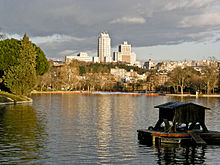Casa de Campo


The Casa de Campo (for Spanish: Country House) is the largest park in Madrid. It is situated west of downtown Madrid, (Spain). It gets its name 'Country House' because it was once a royal hunting estate. Its area is more than 1,750 hectares (6.8 sq mi).[1]
Overview
An amusement park, the Parque de Atracciones de Madrid, and the Madrid Zoo are located inside the park. It is common for families from Madrid to spend days in the park, enjoying the nice weather and looking at the wildlife that may be seen occasionally seen around park with deer, rabbits, and different kinds of birds being the most common.
In 1936–39, during the Spanish Civil War, the front lines of the Siege of Madrid ran through the Casa de Campo, where the Republicans had halted a nationalist offensive in November 1936.
The park can be accessed via the Teleferico, a gondola with pick up point inside the Parque del Oeste on the west end of Madrid. The drop-off point houses a restaurant with an overlook of Madrid, playgrounds (both inside and outside), and access to Casa de Campo's many trails. The trails crisscrossing the park that are great for running, walking, and mountain biking. A lot of the less frequented parts of the park showcase Madrid's natural semi-arid beauty with red soil and scruffy pine trees. The altitude is elevated just like the rest of Madrid with quite a few hills inside the park.
The park has had a bad reputation of being place for prostitutes, most of whom are not Spanish and imported for the sex trade.[2][3][4] The complaints received at the influx of sex workers wearing little clothing has been denied police.[5][6] Due to the park's size, there is still problems but the volume is a lot less with different enforcement measures in place and the rerouting of commuter traffic outside of the park.
See also
References
- ^ Institutp Geográfico Nacional de España. "Visor cartográfico Iberpix". Retrieved 20 July 2014.
- ^ ""Europe's brothel" Spain seeks solutions to prostitution". Khaleej Times. 2006-02-25. Archived from the original on 2006-08-10. Retrieved 2012-08-30.
{{cite web}}: Unknown parameter|deadurl=ignored (|url-status=suggested) (help) - ^ "African Women Being Sold Into European ''Sex Slavery''". Digitaljournal.com. 2001-03-14. Retrieved 2012-08-30.
- ^ Tremlett, Giles (2001-02-28). "African women tricked into sex slavery in Spain". The Guardian. London. Retrieved 2012-08-30.
- ^ Boulware, Jack (2000-07-05). "Hookers at the playground". Salon.com. Retrieved 2012-08-30.
- ^ "Madrid Prostitutes Cleared To Dress Down". Pqasb.pqarchiver.com. 2000-06-28. Retrieved 2012-08-30.
External links
- Parque de Atracciones de Madrid (in Spanish)
- Zoo de Madrid (in Spanish)
- Teleferico
- Google maps
